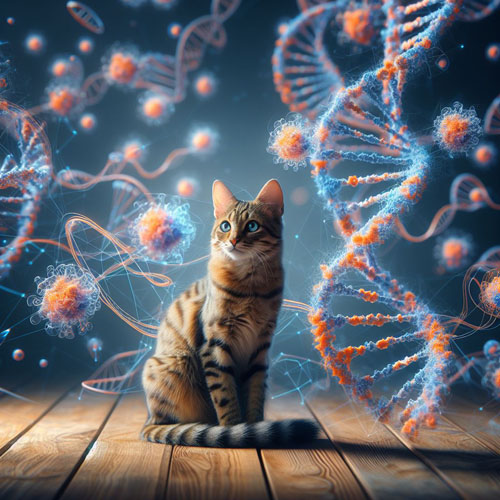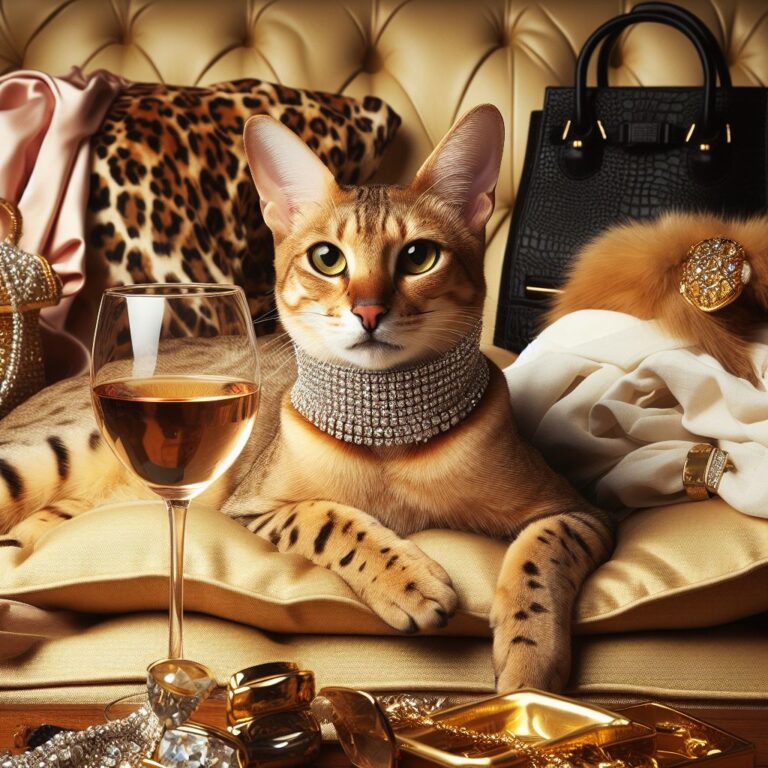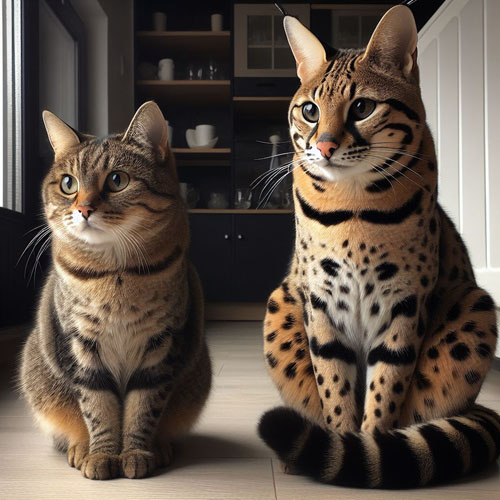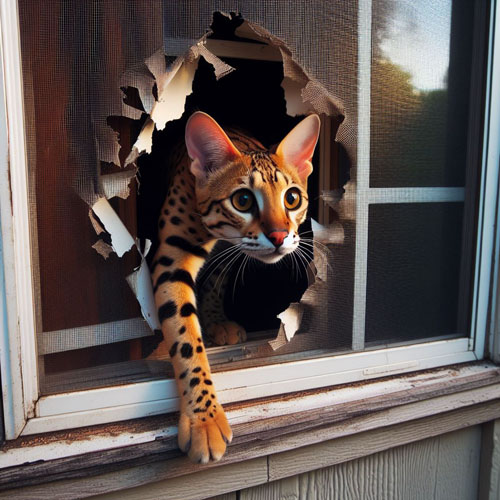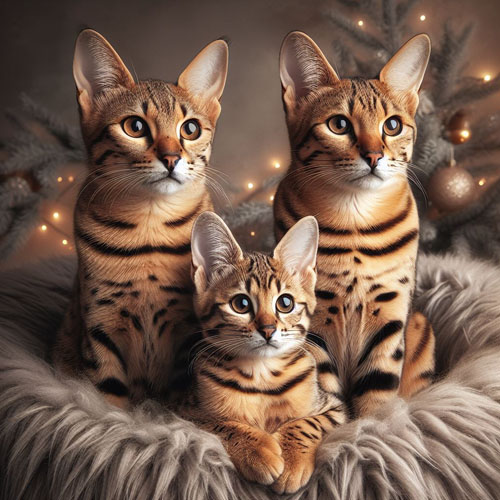A Tale of Two Beauties: Savannah Cat vs. Bengal Cat – Unraveling the Differences
In the realm of hybrid cat breeds, the Savannah cat and Bengal cat stand out as two majestic feline beauties, each possessing unique traits and characteristics. Originating from distinct hybridizations, these 2 breeds captivate cat enthusiasts with their striking appearance and engaging personalities. In this comprehensive exploration, we delve into the similarities and differences between the Savannah cat and the Bengal cat, shedding light on their origins, physical features, temperaments, and considerations for prospective owners.
Origins and Hybridization: The Savannah cat and Bengal cat trace their roots to deliberate hybridization efforts, blending domestic felines with wild cat species to create distinctive breeds that embody the allure of the wild.
- Savannah Cat: The Savannah cat is the result of crossing a domestic cat with a serval, a medium-sized wild African cat. This hybridization, first introduced in the 1980s by breeder Judee Frank, aimed to capture the elegance and exotic appearance of the serval while maintaining a domesticated temperament. Savannah cats are classified into different generations, with F1 being the first generation (50% serval) and subsequent generations denoted by F2, F3, and so on, indicating the percentage of serval ancestry decreases.
- Bengal Cat: The Bengal cat, on the other hand, originated from crossing an Asian leopard cat with a domestic cat. In the 1960s, geneticist Jean Mill embarked on a journey to create a breed that emulated the appearance of wild leopards while possessing a docile temperament suitable for domestic life. The result was the Bengal cat, known for its distinctive spotted or marbled coat and playful nature.
Physical Features: Hybrid cats exhibit a fascinating array of physical features that blend characteristics from both parent types. These unique felines often showcase a combination of sleek domestic cat traits and the distinctive markings or patterns reminiscent of their wild counterparts. The size and build of hybrid cats can vary widely, reflecting the diverse range of wild species involved in their lineage. Additionally, their fur may display captivating patterns, such as spots, stripes, or rosettes, adding to the allure of these extraordinary hybrids. With a diverse mix of physical attributes, hybrid cats captivate enthusiasts with their striking and individualistic appearance.
- Coat Patterns and Colors: Both the Savannah cat and Bengal cat boast eye-catching coat patterns, contributing to their exotic appeal. Savannah cats often display a spotted coat reminiscent of their serval ancestors, with a range of colors including gold, silver, and brown. Bengal cats, on the other hand, exhibit either rosetted, spotted or marbled patterns, with a diverse color palette that includes brown, snow, and silver.
- Size and Build: Savannah cats are notably larger than Bengal cats. The size of a Savannah cat can vary depending on its generation, with F1 and F2 cats resembling the size of a small to medium-sized dog. Their long legs and slender bodies contribute to an athletic and graceful appearance. Bengal cats, while not as large as Savannahs, are muscular and agile, with a medium to large build that reflects their wild ancestry.
Temperament and Behavior: The temperament and behavior of hybrid cats are intriguing blends of their domestic and wild ancestry, resulting in unique and captivating personalities. Hybrid cats often inherit the intelligence, curiosity, and agility of their wild ancestors, making them playful and energetic companions. While they may exhibit a degree of independence reminiscent of their wild relatives, many hybrids also form strong bonds with their human caregivers, displaying affection and loyalty. Socialization plays a crucial role in shaping their behavior, and proper training can help channel their natural instincts positively. Owners of hybrid cats often appreciate their inquisitive nature, but it’s essential to provide them with a stimulating environment to keep them mentally engaged. Striking a balance between their wild instincts and domestic traits, hybrid cats bring a distinctive charm to households willing to understand and cater to their unique behavioral needs.
- Energy Levels: Both breeds share high energy levels, characteristic of their wild lineage. Savannah cats are known for their exceptional athleticism and love for interactive play. Their curiosity and intelligence make them adept at problem-solving and exploring their surroundings. Bengal cats, equally energetic, thrive on playtime and mental stimulation. They may express their energy through climbing and exploring, showcasing a playful and adventurous spirit.
- Socialization: Savannah cats tend to form strong bonds with their human companions and may even exhibit dog-like loyalty. Their social nature makes them well-suited for households with active family members. Bengal cats, while also social, may display more independence and can adapt well to various living environments. Both breeds benefit from interactive play and socialization to ensure a well-rounded and contented temperament.
Considerations for Prospective Owners: Prospective owners of hybrid cats should carefully consider several key factors before welcoming these extraordinary felines into their homes. Firstly, understanding the specific needs of hybrid cats, which arise from the combination of domestic and wild traits, is crucial. These unique felines often require a dedicated and knowledgeable caregiver who can provide a stimulating environment to accommodate their active and intelligent nature. Socialization and early training play pivotal roles in shaping their behavior, necessitating a commitment of time and patience. Additionally, potential owners should be aware of legal regulations regarding hybrid cat ownership in their location, as these regulations can vary. Financial considerations are also important, given potential veterinary costs and the necessity for a secure and spacious living environment. With thorough research and a willingness to meet the distinctive needs of hybrid cats, prospective owners can form fulfilling bonds with these captivating companions.
- Space Requirements: Due to their active nature, both Savannah and Bengal cats benefit from ample space for exercise and play. Savannah cats, especially those of earlier generations, may require more room to accommodate their larger size and energy levels. Bengal cats, while more adaptable to different living spaces, appreciate vertical spaces for climbing and exploring.
- Interaction and Enrichment: Interactive play and mental stimulation are crucial for the well-being of both breeds. Owners of Savannah cats should be prepared to engage in regular play sessions to satisfy their need for physical and mental activity. Similarly, Bengal cats thrive on play and may enjoy puzzle toys and climbing structures to keep them entertained.
- Legal Considerations: Before bringing a Savannah or Bengal cat into your home, it’s essential to be aware of any legal restrictions or requirements. Some regions may have regulations regarding ownership of hybrid breeds, particularly earlier generations of Savannah cats. Prospective owners should research local laws and regulations to ensure compliance.
Conclusion: In the comparison between the Savannah cat and Bengal cat, it becomes evident that both breeds offer unique charms and characteristics. While Savannah cats mesmerize with their regal size, spotted coats, and dog-like loyalty, Bengal cats captivate with their striking spotted or marbled patterns and playful, adaptable nature. Prospective owners should carefully consider their living environment, commitment to interactive play, and awareness of legal considerations when choosing between these two enchanting feline companions. Whether it’s the wild elegance of the Savannah or the playful spirit of the Bengal, both breeds contribute to the rich tapestry of exotic cat ownership, bringing joy and fascination to households worldwide.

